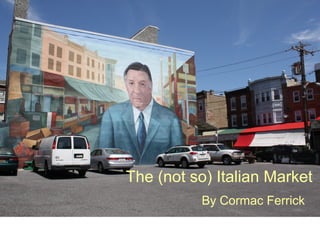Cormac Ferrick Sociology 204 Final Presentation
- 1. The (not so) Italian Market By Cormac Ferrick
- 2. This report is about the bustling and dense section of South Philadelphia known as the Italian Market area. It has a long and rich history.
- 3. Location ?The Market Is located on Ninth Street between Fitzwater and Wharton Streets. ?It stretches along Ninth Street, and extends from storefronts to markets on the sidewalks and sometimes in the streets. ?There is still a lot of mixed-use zoning in the market, but originally many of the shop owners lived directly above their stores. ?This is the place where you find mom and pop stores and neighborhood stores. Although a few stores have expanded outside of Ninth Street.
- 4. History ?Began in mid 1880ˇŻs. Founded by Antonio Palumbo, an Italian Immigrant. ?He opened up a boarding house, occupied solely by Italians, and they needed a place to shop and eat. ?In 1915 the South Ninth Street MenˇŻs Association, comprised of second- generation Italian Americans, was formed. ?The market became a popular place for residents to shop. By the 1940ˇŻs, it had become the largest and longest outdoor Market in America.
- 5. History Continued ?A major dock for passenger ships from Europe was located on the Delaware River at the foot of Washington Avenue, the main east- west thoroughfare. Immigrants would walk off the ship and to nearby boarding homes. ?Most shop owners lived above their stores or rented out the space as a boarding house. ?After World War II many of Italians relocated, along with the rest of America. Moving to the suburbs and South Jersey but still ran their stores. ?There was a period of blight in the neighborhood and there were many vacant storefronts and buildings.
- 6. The Markets Zip Code The market is located in the 19147 zip code, and that is what all of the demographics are of unless stated otherwise.
- 8. Italian Influence ? In 1870, there where only 561 Italians living in Philadelphia. ? By 1920 44,000 Italians resided in South Philadelphia, many of them clustered in row homes near the Market. ? The majority of the stores were owned by Italians during this time, as can be seen by the food sold in the market.
- 9. Demographics ? The Italian Market is located in the 19147 zip code, with a population of 36,228 as of the 2010 Census. ? The number of Hispanics in the zip code account for 10 percent of the population (3,654) with 2,106 of them Mexicans. ? Most of the Mexicans living in the area are illegal immigrants.
- 11. Income and Educational Demographics ? The median household income is 51,753 per year for this zip code ? While the mean is 76,510 ? The median household income in Philadelphia is 36,957 dollars per year
- 12. Housing Demographics ?The average value of a house in this neighborhood is 301,700
- 13. Mexicans in The Market
- 14. Mexicans In the Neighborhood ? There were 6,200 Mexicans living in Philadelphia in 2000. ? By 2010 there were 16,200 Mexicans living within Philadelphia. ? Most come from one part of Mexico, San Mateo Ozolco in the county of Puebla. ? They often come with their relatives, leaving the women and children at home. ? Transnationalism plays an integral part in these peoples daily lives. They are constantly sending money and communicating with relatives in Mexico.
- 16. New Mexican surge ? There are now 27 Mexican business in the market, including seven grocery stores, two hair salons, a record store, and nine restaurants. ? Envios de Paquer¨Şa is a store in the market that allows residents to send money and packages back to Mexico or their homeland, promoting transnationalism.
- 17. MexicanˇŻs Main Strip ? The area has changed from being the main strip for Italian Americans to becoming the main strip for Hispanics, specifically Mexicans from San Mateo Ozolco. ? The market serves as a central shopping and gathering place for people in the area, no matter what ethnicity. ? For 150 years, the neighborhood served as the first American home to new immigrants. It fills that same role today.
- 18. References ? Census Bureau Homepage. N.p., n.d. Web. 15 May 2013. <http://www.census.gov/>. ? Dubin, Mary. South Phialdelphia: Mummers, Memories, and the Melrose Diner. Philadelphia: Temple UP, 1996. Print. ? "Experience The Market." South 9th Street Italian Market. N.p., n.d. Web. 15 May 2013. <http://italianmarketphilly.org/experience-the-market/>. ? Ferrick, Thomas, JR., and Daniel Denvir. "Los Mexicanos De Filadelfia Part Two: Work, Family and Fear." Philadelphia Metropolis. N.p., 29 May 2011. Web. 15 May 2013. <http://www.phlmetropolis.com/2011/05/los-mexicanos-part- one-work-family-and-fear.php>.
- 19. References Continued ? "Italians in Pennsylvania." Pennsylvania Historical & Museum Commission. N.p., n.d. Web. 15 May 2013. <http://www.portal.state.pa.us/portal/server.pt/community/group s/4286/italians/471928>. ? Juliani, Richard N. Building Little Italy: Philadelphia's Italians before Mass Migration. University Park: Pennsylvania State UP, 1998. Print. ? Stanger-Ross, Jordan. Staying Italian: Urban Change and Ethnic Life in Postwar Toronto and Philadelphia. Chicago: University of Chicago, 2010. Print. ? Tigres, Helen. "The Italian Market." Encyclopedia of Greater Philadelphia. N.p., n.d. Web. 15 May 2013. <http://philadelphiaencyclopedia.org/archive/italian-market/>.


















